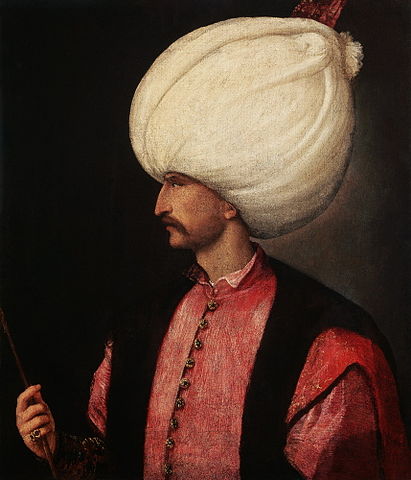
File:EmperorSuleiman.jpg

| |
This is a file from the Wikimedia Commons. Information from its description page there is shown below.
Commons is a freely licensed media file repository. You can help. |
Summary
| DescriptionEmperorSuleiman.jpg |
English: Suleiman I (Ottoman Turkish: سليمان اوّل) was the tenth and longest-reigning Sultan of the Ottoman Empire, from 1520 to his death in 1566. He is known in the West as Suleiman the Magnificent and in the East, as the Lawgiver (Turkish: Kanuni; Arabic: القانونى, al‐Qānūnī), for his complete reconstruction of the Ottoman legal system. Suleiman became a prominent monarch of 16th century Europe, presiding over the apex of the Ottoman Empire's military, political and economic power. Suleiman personally led Ottoman armies to conquer the Christian strongholds of Belgrade, Rhodes, and most of Hungary before his conquests were checked at the Siege of Vienna in 1529. He annexed most of the Middle East in his conflict with the Safavids and large swathes of North Africa as far west as Algeria. Under his rule, the Ottoman fleet dominated the seas from the Mediterranean to the Red Sea and the Persian Gulf.
At the helm of an expanding empire, Suleiman personally instituted legislative changes relating to society, education, taxation, and criminal law. His canonical law (or the Kanuns) fixed the form of the empire for centuries after his death. Not only was Suleiman a distinguished poet and goldsmith in his own right; he also became a great patron of culture, overseeing the golden age of the Ottoman Empire's artistic, literary and architectural development. He spoke six languages: Ottoman Turkish, Arabic, Serbian, Chagatai (a dialect of Turkish language and related to Uighur), Persian and Urdu. In a break with Ottoman tradition, Suleiman married a harem girl, Roxelana, who became Hürrem Sultan; her intrigues as queen in the court and power over the Sultan made her quite renowned. Their son, Selim II, succeeded Suleiman following his death in 1566 after 46 years of rule.বাংলা: প্রথম সুলাইমান (উসমানীয় তুর্কি ভাষায়: سليمان اوّل) ছিলেন উসমানীয় সাম্রাজ্যের দশম এবং সবচেয়ে দীর্ঘকালব্যাপী শাসনরত সুলতান, যিনি ১৫২০ সাল থেকে ১৫৬৬ সালে মৃত্যুর আগ পর্যন্ত উসমানীয় সাম্রাজ্য শাসন করেন। পাশ্চাত্ত্যে তিনি মহৎ সুলাইমান হিসেবে পরিচিত। তিনি পুর্নবারের জন্য সম্পূর্ণভাবে উসমানীয় সাম্রাজ্যের নীতিমালাগুলো তৈরি করেছিলেন বলে প্রাচ্যে তাঁকে বলা হয় বিধানকর্তা সুলাইমান (আরবী ভাষায়: سليمان القانوني)। প্রথম সুলাইমান ষোড়শ শতাব্দীর ইউরোপে একজন বিশিষ্ঠ রাজা হিসেবে স্থান লাভ করেন, যার শাসনামলে উসমানীয় সাম্রাজ্যের সামরিক, রাজনৈতিক ও অর্থনৈতিক শক্তির বিস্তার ঘটে। সুলতান সুলাইমানের সেনাবাহিনী পবিত্র রোমান সাম্রাজ্য এবং হাঙ্গেরির অনেক শহরের পতন ঘটায়। কিন্তু ১৫২৯ সালে পবিত্র রোমান সম্রাট, পঞ্চম চার্লসের সেনাবাহিনী সুলতান সুলাইমানের সেনাবাহিনীকে ভিয়েনা শহর দখল করতে ব্যার্থ করে। প্রথম সুলাইমান পারস্যের সাফাভিদ সুলতান, প্রথম তাহমাসবের বিরুদ্ধে যুদ্ধ পরিচালনা করেন এবং মধ্য প্রাচ্যের বেশীর ভাগ অঞ্চল দখল করে নেন। তিনি উত্তর আফ্রিকায় আলজেরিয়া সহ বড় বড় অঞ্চলগুলো পবিত্র রোমান সাম্রাজ্যের হাত থেকে দখল করে নেয়। তাঁর শাসনামলে উসমানীয় নৌবাহিনী ভূমধ্যসাগর থেকে লোহিত সাগর ও পারস্য উপসাগর পর্যন্ত তাদের আধিপত্য বজায় রাখে।
উসমানীয় সাম্রাজ্যের বিস্তারকালে, সুলতান সুলাইমান ব্যাক্তিগতভাবে তাঁর সাম্রাজ্যের সমাজ ব্যবস্থা, শিক্ষা ব্যবস্থা, খাজনা ব্যবস্থা ও অপরাধের শাস্তি ব্যবস্থার বিষয়গুলোতে আইনপ্রণয়নসংক্রান্ত পরিবর্তন আনার আদেশ দেন। তিনি যেসব কানুনগুলো স্থাপন করে গেছেন, সেসব কানুনগুলো উসমানীয় সাম্রাজ্যে অনেক শতাব্দী ধরে প্রচলিত ছিল। সুলতান সুলাইমান যে শুধু একজন মহান রাজা ছিলেন তা নয়, তিনি একজন মহান কবিও ছিলেন। তাঁর শাসনামলে উসমানীয় সংস্কৃতির অনেক উন্নতি হয়। সুলতান সুলাইমান উসমানীয় তুর্কি ভাষা সহ আরো পাঁচটি ভিন্ন ভাষায় কথা বলতে পারতেন: আরবী ভাষা, সার্বীয় ভাষা, ফার্সি ভাষা, উর্দু ভাষা এবং চাগাতাই ভাষা (একটি বিলুপ্ত তুর্কি ভাষা)। জানা যায় যে, সুলতান সুলাইমান উসমানীয় সাম্রাজ্যের দু'শ বছরের সংসকৃতির নিয়ম ভঙ্গ করে তাঁর হারেমের একজন রমণী, রোক্সেলানার সঙ্গে বিবাহ বন্ধনে আবদ্ধ হন। রোক্সেলানার নাম পরবর্তীকালে হুরেম সুলতান রাখা হয়। তিনি সুলতান সুলাইমানের পুত্র, সেলিম ইবনে সুলাইমানের গর্ভধারণী হন। সুলতান সুলাইমানের মৃত্যুর পর, সেলিম ইবনে সুলাইমান, 'দ্বিতীয় সেলিম' হিসেবে উসমানীয় সাম্রাজ্যের শাহেনশাহ হন। |
|||||||||||||||||||||||
| Date | c. 1530 | |||||||||||||||||||||||
| Source | http://j-times.ru/turciya/garem-sultana-tureckij-vzglyad.html | |||||||||||||||||||||||
| Author |
|
|||||||||||||||||||||||
Licensing
The official position taken by the Wikimedia Foundation is that "faithful reproductions of two-dimensional public domain works of art are public domain, and that claims to the contrary represent an assault on the very concept of a public domain". For details, see Commons:When to use the PD-Art tag. |
|||||
File usage
Metadata
| Copyright holder | © Copyright 2000 Corbis |
|---|---|
| Orientation | Normal |
| Horizontal resolution | 300 dpi |
| Vertical resolution | 300 dpi |
| Software used | ACD Systems Digital Imaging |
| File change date and time | 14:36, 13 December 2006 |
| Y and C positioning | Centered |
| Exif version | 2.2 |
| DateTime subseconds | 390 |
| Keywords |
|
| Short title | OM001305 |
| Source | Meyer; Ali |
| Credit/Provider | © Ali Meyer/CORBIS |
| Headline | Venetian Portrait of Ottoman Sultan Suleyman I |
I want to learn more...
Schools Wikipedia has been carefully checked to give you the best learning experience. In 133 nations around the world, SOS Children's Villages works to bring better education and healthcare to families in desperate need of support. Have you heard about child sponsorship? Learn more...


